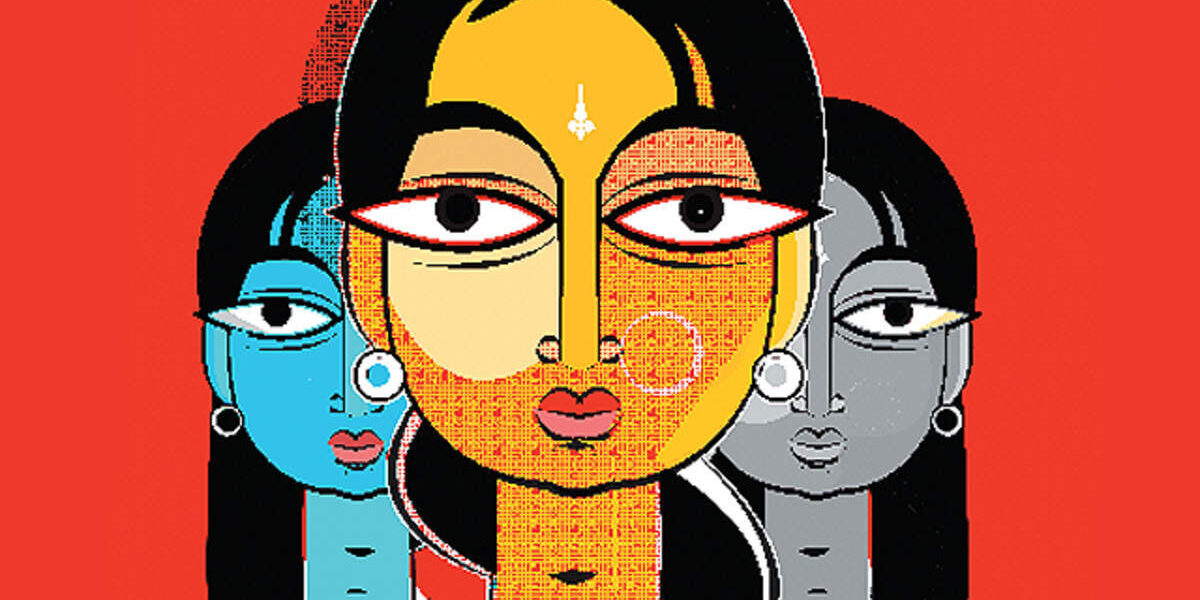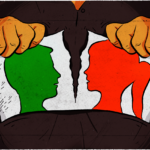
In today’s world, women’s presence can be felt in diverse fields and yet they are treated as second citizens. The deep-rooted notion that women should be confined to homes and look after domestic chores is slowly being broken down and replaced by a new order in which women are emerging as partners and co-workers of men in all walks of life.[2]
The Constitution of India upholds and promotes equality of status and opportunity among all the citizens of the country. The values upon which the Constitution of India is framed, emphasizes on dignity and worth of human person.[3] Article 15 of the Constitution of India lays down that state shall not discriminate against any citizen on the ground of race, religion, caste, sex, etc.[4] The Constitution of India also provide for equality of opportunity in matters of employment or appointment as well under the office of the state. The scheme of the constitution promotes equality and has been framed in a way to offset educational, political and socio-economic hindrances. Despite this, there remains inadequate representation of women in legislative bodies. Empowerment of women is an essential facet of human development. Empowerment of women as a concept intends to eliminate the subordination and subjugation of women and implies manifestation of gender equality in all the walks of life; be it in public or private sphere. An approach should be followed to integrate women in all arenas including political process.[5] Hence, by virtue of article 15(3) of the Constitution, State can make special provisions for women in order to safeguard their interests and to integrate them in the processes at all the levels. Gender balance in political participation and decision-making is the internationally agreed target set in the Beijing Declaration and Platform for Action.[6] Despite this there is inadequate representation of women in legislative bodies. Though in panchayat and municipality elections, one third of the total seats have been reserved for women but no such reservation of seats has been done in other legislative bodies at state level and central level. There are many countries which have reserved the seats for women in order to integrate them in decision making process but in India there is no such reservation. The Women Reservation Bill was introduced in India in 1996 and was passed by the upper house in 2010 but since then the bill has lapsed. This bill aimed at reserving 33 per cent of the seats for women in the Lok Sabha and all state legislative assemblies for women.
This paper seeks to i) highlight the inadequate representation of women in legislative bodies and their reason thereof; ii) compare the representation of women parliamentarians globally; and iii) to propose reforms in order to increase representation of women in parliament
Inadequate representation of women in Legislative bodies in India
The Inter-Parliamentary Union and UN Women released Women in Politics Map 2020 which showed the rankings of the member state based on percentage of women in ministerial positions reflecting appointments up to 1st January 2020 and women in parliament and percentage of women in unicameral parliaments or the lower house of parliament, reflecting elections/appointments up to 1 January 2020.[7] According to the map, India currently ranks at 142 in World ranking for number of women parliamentarians. The report also provided that women comprise 14.4% of the Lok Sabha with 78 women elected to the 543-member house and 10.4% of the Rajya Sabha with 25 of 240 members. India ranked 134 with regard to percentage of women in ministerial positions. Few women hold important positions in the Cabinet.
The data compiled in table no.1 below shows the percentage of women member in Lok sabha in India. Sixteenth Lok Sabha saw highest percentage of women members as compared to earlier Lok Sabha sessions.
It is important there is adequate representation of women in legislative bodies and in politics. John Stuart Mill highlighted that the participation of both the majority and minority needs to be ensured in order to have an efficient and competent government. Women were included in this definition within the word ‘minority’.[8] Increasing of women participation is necessary because of the following reasons: firstly, democracy and equality demands proportional representation of women in politics, secondly, inadequate representation questions the legitimacy of democratic process. Thirdly, adequate representation will open new spaces for them.[9]
|
Lok Sabha |
Year |
Total no. of seats |
No. of Women MPs |
Percentage of Women MP’s |
|
1 |
1951 |
449 |
22 |
4.41 |
|
2 |
1957 |
500 |
27 |
5.4 |
|
3 |
1962 |
503 |
34 |
6.76 |
|
4 |
1967 |
523 |
31 |
5.93 |
|
5 |
1971 |
521 |
22 |
4.22 |
|
6 |
1977 |
544 |
19 |
3.49 |
|
7 |
1980 |
544 |
28 |
5.15 |
|
8 |
1984 |
544 |
44 |
8.09 |
|
9 |
1989 |
517 |
27 |
5.22 |
|
10 |
1991 |
544 |
39 |
7.17 |
|
11 |
1996 |
543 |
39 |
7.18 |
|
12 |
1998 |
543 |
43 |
7.92 |
|
13 |
1999 |
543 |
49 |
9.02 |
|
14 |
2004 |
543 |
45 |
8.28 |
|
15 |
2009 |
543 |
59 |
10.86 |
|
16 |
2014 |
542 |
64 |
11.8 |
|
17 |
2019 |
78 |
14.4 |
Table 1: Percentage of women MPs in Lok Sabha
Source: National Portal of India: Who’s who, Lokh Sabha[10] and First Post.[11]
The graph below explains the highs and lows in the number of women members in Lok Sabha in India from the year 1957 to 2014.With every new session of Lok Sabha the number of women member have increased and reduced as well. In the year 2014, women comprised 11.8 percent of total members in Lok Sabha. The 17th Lok Sabha saw highest number of women representatives ever. Women will account for 14.4% of the entire strength of the Lok Sabha, which was comparatively low in the 2014. The percentage of women as members in Lok Sabha is comparatively low if we compare it with other countries like Rwanda, China, Russia, Afghanistan etc.[12]
Causes for low representation of women in Lok Sabha
It is often said that the proper place for women is her home and she should pursue building a happy family. The chief duty of the women is to look after domestic chores.[13] In many sections of Indian society, the public appearance of women is looked down upon. In India the patriarchal structure is still strong. There is a certain kind of a taboo attached to working women. Such an attitude has restricted their participation in public domain.[14] “For entering politics at the state level or at higher level a women should normally be of strong character, free from domestic responsibilities, highly educated, financially well off, commanding resect in the society and capable of discharging her duties firmly and independently.”[15] A very pertinent question that needs attention is that; why does a woman has to choose between her domestic responsibilities and professional forefront? If a woman can efficiently run a house hold, she can very well take political decisions and can play significant part in the political system.
The problems, which a member of state legislative assembly has to face, namely, are character assassination and false insinuations.[16] There are also cases wherein women have the ability to participate in public life but are reluctant because of expenses involved and difficulties involved in campaigning process.[17]
Women Parliamentarian’s globally
According to UN women facts on leadership and political participation, only 24.5 per cent of all national parliamentarians were women as of Jan 2019.[18]
Rwanda has the highest number of women parliamentarians worldwide.[19] The Lower house in Rwanda comprise of 61.3 per cent of women as up to 1st January 2020.[20] Only four countries have 50 per cent or more women members in parliament in lower house namely: Rwanda with 61.3 per cent, Cuba with 53.2%, Bolivia with 53.1 per cent and UAE with 50%.[21] It is commendable that these countries have more than 50 per cent women members in lower house. Rwanda has taken a full stride towards gender equality in government. 20 Countries have crossed the 40 per cent mark which includes Mexico, South Africa, Mozambique, Sweden etc as of 1st January 2020.[22] Nepal ranks 43 while Pakistan ranks 106 as per the data compiled by UN women.
Most of the countries where in the women membership in parliaments is quite high have applied some form of quota system either through legislative candidate quota or reserved seats which has opened space for women’s political participation.[23] Rwanda is the only country in the world where there are more women serving as elected officials than men.[24] This small country which is landlocked in middle of sub Saharan Africa, has more of women as elected officials than men and have grown astoundingly.[25] The genocide in Rwanda led to violence and killings mostly perpetrated by and against men and aftermath of genocide saw more percentage of the women in the country. Women only held around 10-15 per cent of seats in parliaments before 1994.[26]
The Rwandan government approved the new Constitution in 2003 which provided for a minimum 30 per cent quota for women in all decision-making organs including parliament and other government bodies.[27] There is also an astonishing provision according to which only women can vote for women only seats. The reservation of minimum seats for women showed great results as the percentage of women in parliament increased drastically.[28] In 2013, the percentage of women in parliament had a great rise to 64 per cent.[29] This system actually helped in integration of women in political processes. In Rwanda, all women at the age of 18 become member of National Women’s Council (NWC) which is a forum for women’s participation in national development and governance. The National Women’s Council operates at every level to mobilize women’s decision-making. At the time of parliamentary elections, the National Women’s Council train women candidates on effective campaigning, building self-esteem and confidence, and how to promote gender equality once elected.[30]Also, there is gender monitoring of election through the Gender Monitoring Office which is a governmental body.[31]
Article 83 of the Constitution of Afghanistan provides that “…. the elections law shall adopt measures to attain, through the electorate system, general and fair representation for all the people of the country, and proportionate to the population of very province, on average, at least two females shall be the elected members of the House of People from each province.”[32] Countries like Afghanistan, United Kingdom, Iran etc have reserved seats for women. In India there is no reservation of seats for women in legislative bodies but by 73rd and 74th amendment in the Constitution of India, reservation of not less than one third of the total number of seats for women has been made in panchayats and municipality elections respectively.
Need for Electoral reforms
It is of utmost significance that women are adequately integrated into the political process and reforms should be made for political empowerment of women. Integration in the political process can be achieved by the policy of reservation.[33] Reservation can be used as an effective tool to achieve gender equality in politics. Affirmative action by the way of reservation has been extended to SC’s and ST’s as well. Seats have been reserved for them in legislative assemblies of the state as well as in the Lok Sabha vide article 330 and 332 of the constitution. By virtue of article 15(3), reservation for women in legislative bodies can also be made. There is no reservation of seats for women in lok sabha and other legislative bodies but by the insertion of 73rd and 74th amendment in the Constitution of India, one third of the total number of seats have been reserved for women in panchayat and municipality lections. Various research on panchayats in India have shown that number of drinking water projects in areas with women-led councils was 62 per cent higher than in those with men-led councils.[34] In Norway, a direct causal relationship between the presence of women in municipal councils and childcare coverage was found increased membership in Lok Sabha and also in council of ministers can help in attaining the gender equality in all areas. Reservation of seats can be used as a tool for political empowerment of women.[35] The representation of women in legislative bodies is minimal in India and also in many other countries as described above in the table no.
In many countries, seats are reserved for women in parliament to ensure that there is a political balance of power and gender equality in all political processes. The new approved Rwandan Constitution incorporated the system of reservation of seats for women in parliament which proved to be an effective tool for increasing women representation in parliament and decision making political processes.
Affirmative action can be designed to overcome the barriers to gender equality and to compensate for past and resent discrimination and improve their status.[36] The women’s reservation bill is opposed on the ground that the reservation would provide an opportunity to woman to yield power and it would corrupt the culture which enjoins heavy duty on women regarding upbringing of the child and to provide a happy home.[37] This is reinforcing patriarchy and the notion that women should be confined to homes as all they can do is raise a child and build home and not a nation.
Reservation in panchayat is somewhat different because women can handle local issues with strong common sense, so does that mean she cannot take decisions which can have bearing on the whole nation? It is fuelling the idea that woman are not capable of making decisions regarding important matters and those matters which have wide outreach.
Reservation policy can be good reform to empower women in political areana. There are other alternative to reservation as well which are introduced by the countries. Zipper system was introduced in the elections to the European parliament.[38] This system imposes a gender quota, mandating political parties to alternate female and male candidates on candidate lists.[39] Even the Swedish parties use this system to achieve gender balance amongst their elected representative.
“The quotas can be put into place in two major ways: Firstly, many parties voluntarily adopt zipper systems without legislative requirements to do so. These are called party quotas, or voluntary party quotas, and they are adopted by individual parties for their own candidate lists (usually enshrined in party statutes and rules). Strict gender alternation is used by many Green parties and Social Democratic parties in Europe, for instance, and in other progressive parties around the world. Secondly, zipper systems and their variants can be introduced through legislated candidate quotas, which regulate the gender composition of the candidate lists and are binding by law for all political parties in the election.”[40]
Apart from tis, it is incumbent upon the parties as well to not discriminate against women and carry out positive acts like training women regarding nuances of politics etc.[41]
Conclusion
There should be adequate representation of women in lok sabha. The President of United States Johnson’s speech in Harvard University in 1960 provided that:[42]
“Freedom is not enough but freedom is not enough. You do not wipe away the scars of centuries by saying: Now you are free to go where you want, and do as you desire, and choose the leaders you please. You do not take a person who, for years, has been hobbled by chains and liberate him, bring him up to the starting line of a race and then say, “you are free to compete with all the others,” and still justly believe that you have been completely fair.”
This excerpt reflects that the person who has been hobbled by chains cannot be merely asked one fine day to freely compete with others and granted freedom without doing something more. It is incumbent that something is done to offset all the barriers that might come up in the way. The historical suppression and subjugation that women faced can be mitigated to some extent by the way of affirmative action by the state. Reservations can be used as a tool to effectuate women’s adequate representation in parliament. There are countries like Rwanda, Afghanistan, Iran etc which came up with reservation to integrate women in political processes.
The Beijing Platform of Action reaffirmed that women rights are human rights and also laid emphasis on the significance of women’s full participation in all spheres including decision making. It can be said that empowerment of women through adequate representation in the parliament and in decision making process is the need of the hour, if the country strives for gender quality. Women demonstrate political leadership by working across party lines through parliamentary women’s caucuses – even in the most politically combative environments – and by championing issues of gender equality, such as the elimination of gender-based violence, parental leave and childcare, pensions, gender-equality laws and electoral reform.
The Constitution of India expressly provide for affirmative action for women and other disadvantaged groups and allows the state to make special provision for women. Still no measures have been taken to increase the representation of women in parliament in India through measures like 73rd and 74th amendment of the Constitution has tried to increase women’s representation in parliament. Last but not the least, Rabindranath Tagore said that “At the present stage of history, the civilization is masculine, a civilization of power, in which women have been thrust aside in the shade. The time has arrived when women must step in and impart her life rhythm to this reckless movement of power.”[43]
Photo Source: Economic Times
-
Research Scholar, Maharashtra National Law University, Mumbai ↑
-
Parkash Chander, “Women Members in Lok Sabha” 19 Journal of Parliamentary Information 53(1973). ↑
-
Id. at 2 ↑
-
The Constitution of India, art., 15 reads as: (1) The State shall not discriminate against any citizen on grounds only of religion, race, caste, sex, place of birth or any of them
(2) No citizen shall, on grounds only of religion, race, caste, sex, place of birth or any of them, be subject to any disability, liability, restriction or condition with regard to
(a) access to shops, public restaurants, hotels and palaces of public entertainment; or
(b) the use of wells, tanks, bathing ghats, roads and places of public resort maintained wholly or partly out of State funds or dedicated to the use of the general public
(3) Nothing in this article shall prevent the State from making any special provision for women and children ↑
-
Pradeep chaturvedi, “Empowering women: a study showing impact of reservation of seats in the lok sabha 1 DU Law Journal 59 (1997). ↑
-
Facts and figures: Leadership and political participation available at: http://www.unwomen.org/en/what-we-do/leadership-and-political-participation/facts-and-figures#sthash.H8P8kUkI.dpuf ( last visited on April 20, 2020).
-
Women in political map available at: https://www.unwomen.org/-/media/headquarters /attachments/sections/ library/publications/2020/women-in-politics-map-2020-en.pdf?la=en&vs=827 (last visited on January 10, 2021). ↑
-
Pranab kumar pandey , “Representation without Participation: Quotas for Women in Bangladesh” 4 International Political Science Review 489 (2008). ↑
-
Id. at 491 ↑
-
Lok Sabha available at: https://india.gov.in/my-government/indian-parliament/lok-sabha (last visited on April 10, 2017). ↑
-
Where are the women? Political power is still a male domain in India available at: http://www.firstpost.com/ politics/where-are-the-women-political-power-is-still-a-male-domain-in-india-2816568.html (last visited on April 10, 2017). ↑
-
Supra note 7. ↑
-
Supra note 2 at 56. ↑
-
Vinutha, “Women’s Reservation Bill: An unending Politics” 35 Journal of Constitution and Parliamentary Studies 96 (2001). ↑
-
J. SMN Raina, “Propriety of reservation for women in state legislative assemblies and lok sabha”19 Central India Law Quarterly 86 (1999). ↑
-
Supra note 15. ↑
-
Supra note 2. ↑
-
Women in national parliament available at: http://www.ipu.org/wmn-e/world.htm (last visited on April 25, 2017). ↑
-
Supra note 7. ↑
-
Ibid. ↑
-
Ibid. ↑
-
Ibid. ↑
-
Supra note 6. ↑
-
Rwanda strides towards gender equality in government available at: http://harvardkennedyschoolreview.com/ rwanda-strides-towards-gender-equality-in-government/ (last visited on Dec 20, 2020). ↑
-
Ibid. ↑
-
Ibid. ↑
-
Women secure 64 percent seats available at: http://www.rw.one.un.org/press-center/news/women-secure-64-cent-seats-rwandan-parliamentary-elections (last visited on Dec 20, 2020). ↑
-
Supra note 27. ↑
-
Ibid. ↑
-
Supra note 30. ↑
-
Ibid. ↑
-
The Constitution of Islamic republic of Afghanistan available at: http://www.diplomatie.gouv.fr/IMG/pdf/ The_Constitution_of_the_Islamic_Republic_of_Afghanistan.pdf (last visited on Setember 25, 2020). ↑
-
Supra note 5. ↑
-
Supra note 6. ↑
-
Supra note 5. ↑
-
Supra note 14. ↑
-
Supra note 15. ↑
-
Supra note 14 at 105. ↑
-
Zipper system available at: http://www.rappler.com/nation/politics/elections/2016/129938-zipper-system-get-more-women-elected-congress (last visited on October 25, 2020). ↑
-
Ibid. ↑
-
Supra note 14. ↑
-
Speech available at: http://www.presidency.ucsb.edu/ws/?pid=27021 (last visited don September 5, 2020). ↑
-
Roopa Sharma, “The women reservation bill” 7 MDU Law Journal 213 (2002). ↑





WOW just what I was looking for. Came here by searching for website
I don’t even understand how I finished up right here, but I assumed this publish used
to be great. I do not recognize who you are but certainly you are
going to a famous blogger when you aren’t already.
Cheers!
I’ll right away seize your rss as I can not in finding your email
subscription hyperlink or e-newsletter service. Do you have any?
Kindly permit me know in order that I could subscribe.
Thanks.